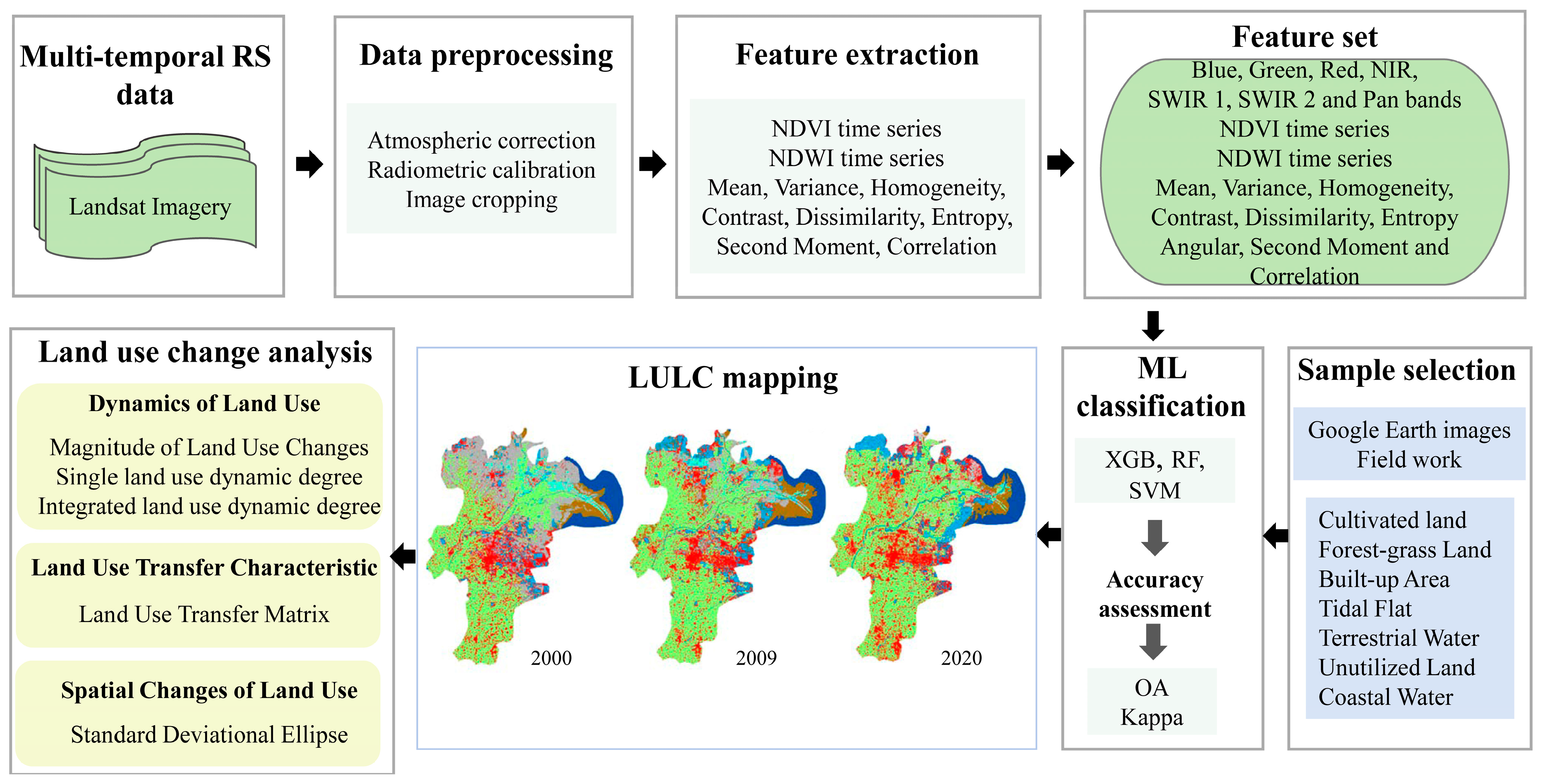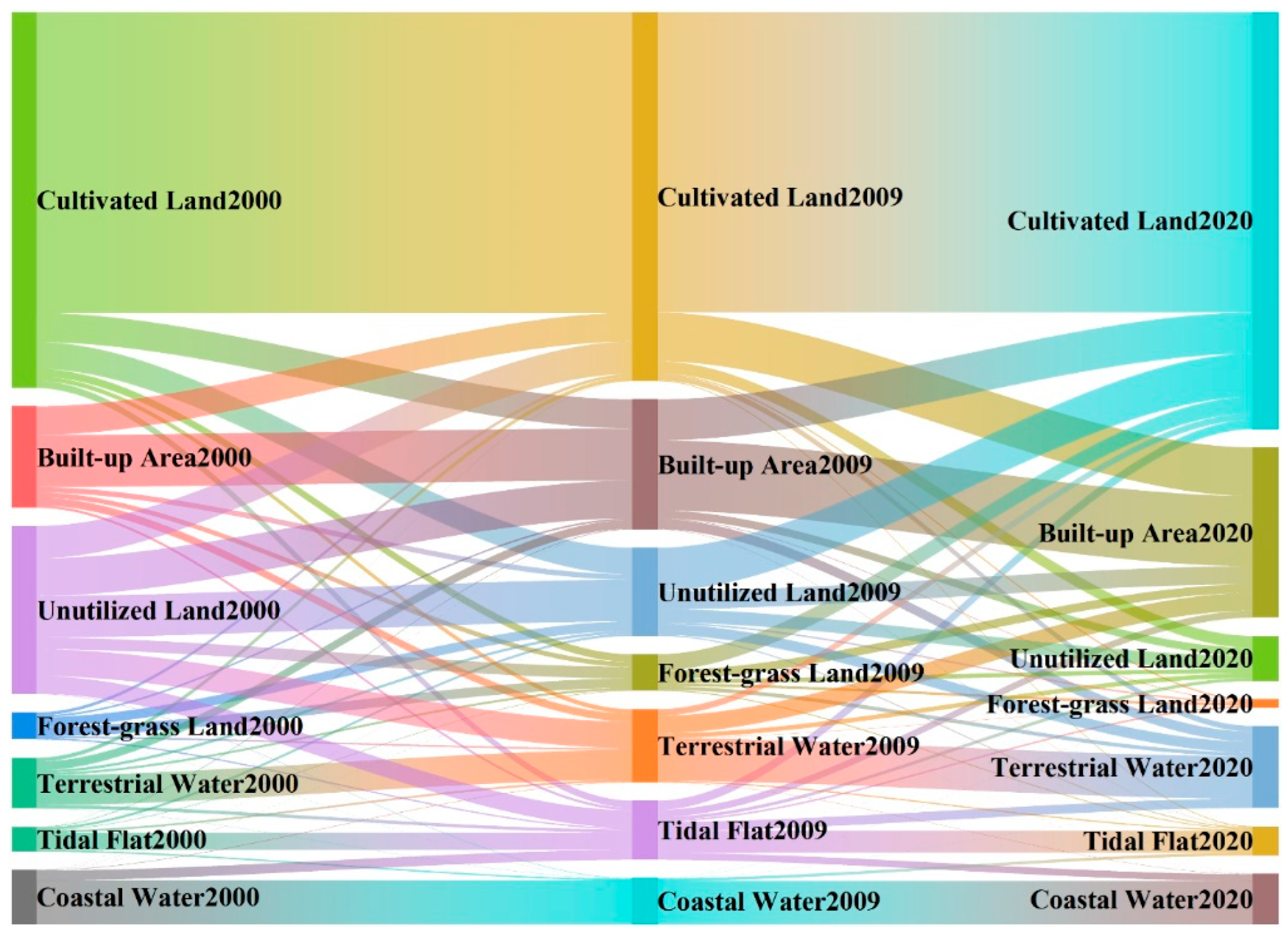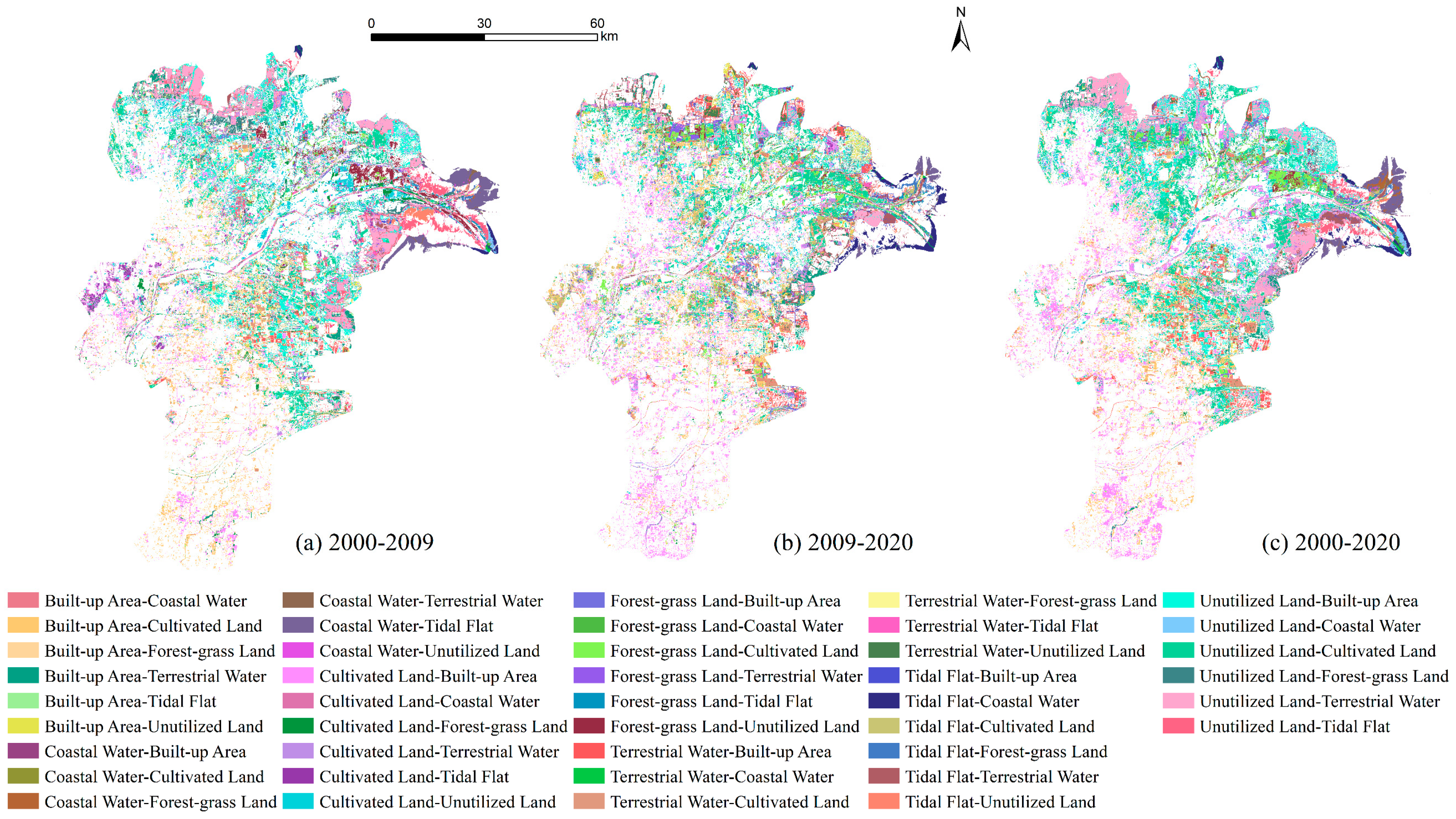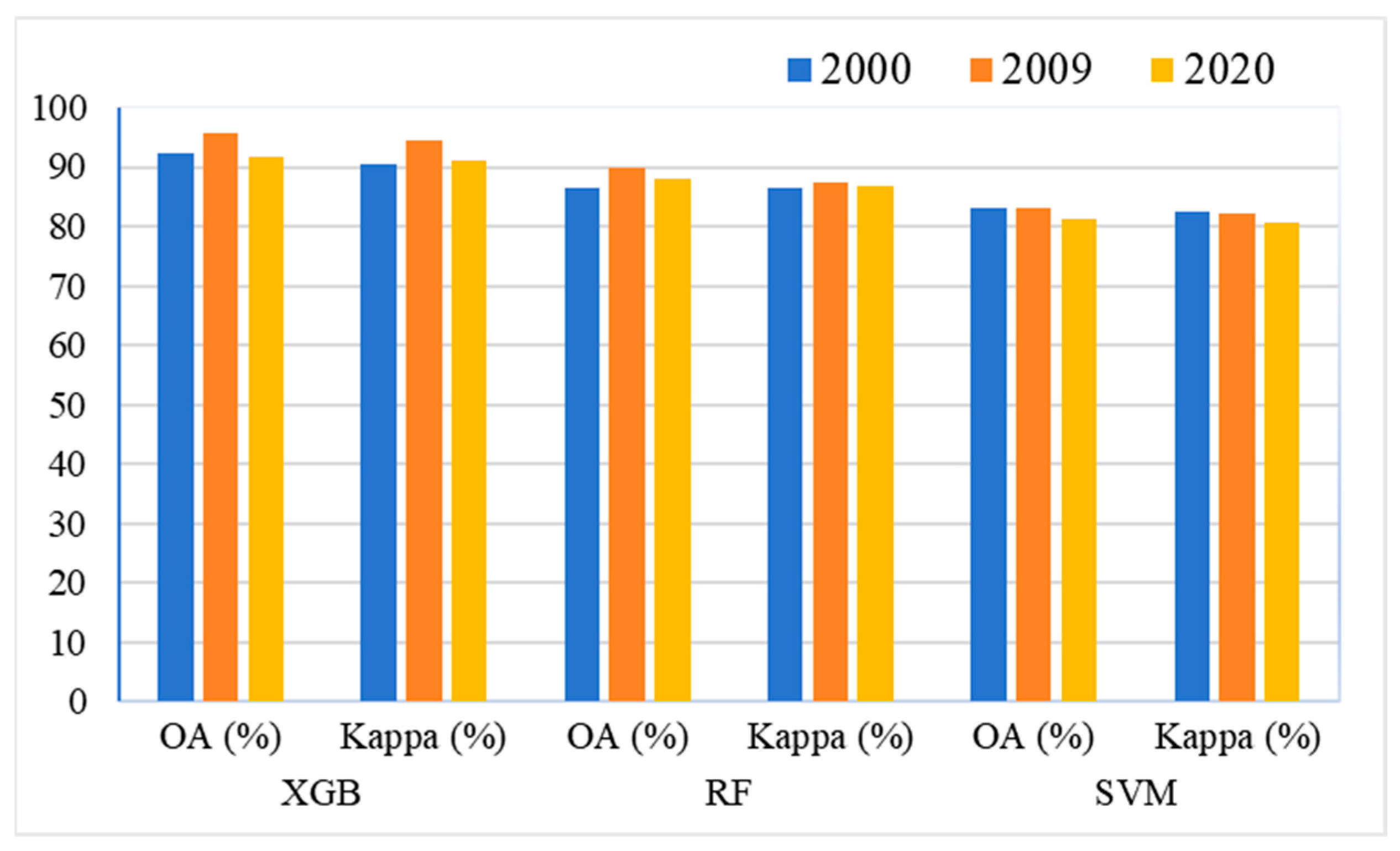Monitoring Land Use Changes in the Yellow River Delta Using Multi-Temporal Remote Sensing Data and Machine Learning from 2000 to 2020
Abstract
:1. Introduction
2. Study Area and Dataset
2.1. Study Area
2.2. Remote Sensing Data
3. Methodology
3.1. Land Use Classification
3.1.1. Image Features
- (1)
- Image band
- (2)
- Spectral index
- (3)
- Textural feature
3.1.2. Machine Learning Methods
3.1.3. Training, Testing, and Validation
3.2. Land Use Transfer Matrix
3.3. Land Use Dynamics
3.3.1. Magnitude of Land Use Changes
3.3.2. Single Land Use Dynamic Degree
3.3.3. Integrated Land Use Dynamic Degree
3.4. Standard Deviational Ellipse
4. Results
4.1. Land Use Classification and Distribution
4.2. Land Use Transfer Characteristic
4.3. Spatial Changes of Land Use
5. Discussion
5.1. Land Use Classification Method
5.2. Spatial Differentiation of Land Use Change
5.3. Limitations and Future Directions
6. Conclusions
Author Contributions
Funding
Data Availability Statement
Conflicts of Interest
Appendix A
| Time Period | Sensor | Acquisition Time | Path/Row | Cloud Coverage (%) |
|---|---|---|---|---|
| 2000 | Landsat5 TM | 20 December 2000 | 121/34 | 2.00 |
| 2000 | Landsat5 TM | 2 November 2000 | 121/34 | 1.00 |
| 2000 | Landsat5 TM | 17 October 2000 | 121/34 | 1.00 |
| 2000 | Landsat5 TM | 15 September 2000 | 121/34 | 4.00 |
| 2000 | Landsat5 TM | 8 April 2000 | 121/34 | 0.00 |
| 2000 | Landsat5 TM | 7 March 2000 | 121/34 | 1.00 |
| 2000 | Landsat7 ETM+ | 9 October 2000 | 121/34 | 0.00 |
| 2000 | Landsat7 ETM+ | 2 May 2000 | 121/34 | 1.00 |
| 2000 | Landsat7 ETM+ | 28 February 2000 | 121/34 | 0.00 |
| 2000 | Landsat7 ETM+ | 17 January 2000 | 121/34 | 7.00 |
| 2009 | Landsat5 TM | 13 December 2009 | 121/34 | 9.00 |
| 2009 | Landsat5 TM | 26 October 2009 | 121/34 | 2.00 |
| 2009 | Landsat5 TM | 3 May 2009 | 121/34 | 0.00 |
| 2009 | Landsat5 TM | 1 April 2009 | 121/34 | 0.00 |
| 2009 | Landsat5 TM | 16 March 2009 | 121/34 | 4.00 |
| 2009 | Landsat5 TM | 27 January 2009 | 121/34 | 2.00 |
| 2020 | Landsat8 OLI | 27 December 2020 | 121/34 | 5.74 |
| 2020 | Landsat8 OLI | 9 November 2020 | 121/34 | 0.00 |
| 2020 | Landsat8 OLI | 24 October 2020 | 121/34 | 0.28 |
| 2020 | Landsat8 OLI | 20 July 2020 | 121/34 | 0.28 |
| 2020 | Landsat8 OLI | 1 May 2020 | 121/34 | 0.50 |
| 2020 | Landsat8 OLI | 15 April 2020 | 121/34 | 5.67 |
| 2020 | Landsat8 OLI | 14 March 2020 | 121/34 | 0.22 |
| From 2000 to 2009 | Tidal Flat | Cultivated Land | Coastal Water | Built-Up Area | Forest–Grassland | Terrestrial Water | Unutilized Land | Total in 2009 | Transfer to |
|---|---|---|---|---|---|---|---|---|---|
| Tidal Flats | 159.45 | 65.41 | 90.03 | 23.19 | 12.99 | 29.55 | 162.35 | 542.97 | 383.52 |
| Cultivated Land | 1.79 | 2762.26 | 0.02 | 262.68 | 28.45 | 36.26 | 297.14 | 3388.59 | 626.33 |
| Coastal Water | 14.13 | 0.13 | 403.26 | 0.02 | 0.73 | 1.87 | 4.77 | 424.93 | 21.66 |
| Built-up Area | 6.64 | 266.64 | 0.59 | 478.08 | 16.39 | 80.22 | 345.03 | 1193.58 | 715.51 |
| Forest–Grassland | 5.60 | 71.00 | 0.68 | 45.02 | 87.48 | 20.48 | 106.36 | 336.61 | 249.13 |
| Terrestrial Water | 8.31 | 41.26 | 4.83 | 72.56 | 15.34 | 274.51 | 245.57 | 672.39 | 397.88 |
| Unutilized Land | 21.54 | 244.84 | 0.61 | 49.37 | 87.20 | 24.30 | 382.28 | 810.13 | 427.86 |
| Total in 2000 | 227.46 | 3451.54 | 500.03 | 930.91 | 248.58 | 467.19 | 1543.50 | 7369.21 | |
| Transfer Out | 68.01 | 689.28 | 96.76 | 452.83 | 161.10 | 192.67 | 1161.22 |
| From 2009 to 2020 | Tidal Flat | Cultivated Land | Coastal Water | Built-Up Area | Forest–Grassland | Terrestrial Water | Unutilized Land | Total in 2020 | Transfer to |
|---|---|---|---|---|---|---|---|---|---|
| Tidal Flats | 200.73 | 8.18 | 26.04 | 2.88 | 9.04 | 11.86 | 10.36 | 269.10 | 68.37 |
| Cultivated Land | 85.33 | 2759.65 | 0.09 | 375.99 | 149.82 | 60.78 | 397.61 | 3829.27 | 1069.63 |
| Coastal Water | 63.50 | 0.06 | 396.60 | 0.29 | 0.44 | 2.90 | 0.13 | 463.93 | 67.32 |
| Built-up Area | 64.61 | 446.41 | 0.60 | 643.84 | 79.26 | 162.38 | 166.44 | 1563.54 | 919.70 |
| Forest–Grassland | 15.19 | 13.17 | 0.89 | 5.83 | 24.07 | 3.02 | 14.81 | 76.97 | 52.90 |
| Terrestrial Water | 84.34 | 52.30 | 0.74 | 92.42 | 34.97 | 389.92 | 99.00 | 753.70 | 363.77 |
| Unutilized Land | 29.33 | 109.03 | 0.01 | 72.72 | 39.04 | 41.69 | 121.84 | 413.66 | 291.81 |
| Total in 2009 | 543.03 | 3388.79 | 424.98 | 1193.97 | 336.64 | 672.55 | 810.20 | 7370.17 | |
| Transfer Out | 342.30 | 629.15 | 28.37 | 550.13 | 312.57 | 282.63 | 688.36 |
| From 2000 to 2020 | Tidal Flat | Cultivated Land | Coastal Water | Built-Up Area | Forest–Grassland | Terrestrial Water | Unutilized Land | Total in 2020 | Transfer to |
|---|---|---|---|---|---|---|---|---|---|
| Tidal Flats | 108.10 | 7.67 | 74.57 | 1.89 | 10.81 | 8.14 | 57.90 | 269.09 | 160.98 |
| Cultivated Land | 8.90 | 2742.02 | 1.89 | 320.92 | 116.44 | 84.33 | 554.73 | 3829.23 | 1087.20 |
| Coastal Water | 40.23 | 0.29 | 405.22 | 0.17 | 2.67 | 4.19 | 11.13 | 463.90 | 58.68 |
| Built-up Area | 13.21 | 478.59 | 1.45 | 500.37 | 40.30 | 149.73 | 379.69 | 1563.34 | 1062.98 |
| Forest–Grassland | 5.91 | 14.08 | 11.94 | 2.94 | 23.33 | 2.86 | 15.92 | 76.97 | 53.64 |
| Terrestrial Water | 39.26 | 89.41 | 3.79 | 78.47 | 18.31 | 195.69 | 328.68 | 753.62 | 557.93 |
| Unutilized Land | 11.86 | 119.68 | 1.19 | 26.25 | 36.74 | 22.31 | 195.60 | 413.63 | 218.03 |
| Total in 2000 | 227.47 | 3451.75 | 500.04 | 931.01 | 248.60 | 467.25 | 1543.65 | 7369.77 | |
| Transfer out | 119.37 | 709.72 | 498.60 | 904.76 | 225.27 | 271.56 | 1348.06 |
| Land Use Categories | Year | Circumference (km) | Area (km2) | X-Coordinate of Centroid (km) | Y-Coordinate of Centroid (km) | Short Axis (km) | Long Axis (km) | Orientation Angle (°) | Ellipticity |
|---|---|---|---|---|---|---|---|---|---|
| Cultivated Land | 2000 | 205.77 | 3247.25 | 646,798.96 | 4,174,407.97 | 27,464.64 | 37,637.21 | 2.15 | 0.07 |
| 2009 | 196.21 | 2905.03 | 643,006.59 | 4,169,677.33 | 25,163.44 | 36,749.99 | 15.35 | 0.08 | |
| 2020 | 213.99 | 3452.67 | 645,325.56 | 4,166,492.82 | 27,394.74 | 40,120.42 | 17.35 | 0.08 | |
| Tidal Flats | 2000 | 181.00 | 2610.80 | 657,651.53 | 4,177,004.91 | 27,739.98 | 29,959.82 | 21.17 | 0.02 |
| 2009 | 190.26 | 2877.88 | 645,618.06 | 4,175,339.75 | 29,542.20 | 31,009.98 | 170.30 | 0.01 | |
| 2020 | 188.32 | 2787.19 | 659,094.67 | 4,178,532.00 | 27,192.11 | 32,628.44 | 79.64 | 0.04 | |
| Built-up Area | 2000 | 209.05 | 3130.45 | 634,686.96 | 4,161,262.76 | 24,143.63 | 41,274.99 | 178.39 | 0.10 |
| 2009 | 210.99 | 3376.20 | 637,611.91 | 4,166,429.24 | 27,384.55 | 39,246.40 | 15.24 | 0.08 | |
| 2020 | 229.60 | 3969.69 | 640,040.13 | 4,166,034.79 | 29,307.79 | 43,117.26 | 14.11 | 0.08 | |
| Terrestrial Water | 2000 | 203.15 | 3171.88 | 640,818.70 | 4,163,902.54 | 27,271.67 | 37,023.78 | 18.24 | 0.07 |
| 2009 | 207.87 | 3364.95 | 642,301.48 | 4,165,580.94 | 29,019.99 | 36,910.93 | 25.05 | 0.05 | |
| 2020 | 213.17 | 3470.62 | 650,257.66 | 4,168,391.28 | 28,150.52 | 39,246.16 | 18.73 | 0.07 | |
| Forest–Grassland | 2000 | 175.37 | 2284.24 | 655,311.21 | 4,183,997.58 | 21,722.14 | 33,474.80 | 24.01 | 0.09 |
| 2009 | 225.26 | 3695.29 | 642,909.31 | 4,166,079.58 | 26,826.85 | 43,848.96 | 27.54 | 0.10 | |
| 2020 | 202.78 | 2858.72 | 658,418.13 | 4,174,417.75 | 22,238.98 | 40,920.71 | 44.46 | 0.11 | |
| Unutilized Land | 2000 | 191.08 | 2876.53 | 644,248.64 | 4,172,020.20 | 27,888.25 | 32,833.78 | 167.41 | 0.04 |
| 2009 | 186.26 | 2747.38 | 642,200.81 | 4,175,107.73 | 27,934.18 | 31,307.99 | 24.59 | 0.03 | |
| 2020 | 188.85 | 2829.25 | 646,799.08 | 4,177,460.38 | 28,685.99 | 31,395.97 | 33.36 | 0.02 |
References
- Wang, H.; Liu, Y.; Wang, Y.; Yao, Y.; Wang, C. Land Cover Change in Global Drylands: A Review. Sci. Total Environ. 2023, 863, 160943. [Google Scholar] [CrossRef]
- Grimm, N.B.; Faeth, S.H.; Golubiewski, N.E.; Redman, C.L.; Wu, J.; Bai, X.; Briggs, J.M. Global Change and the Ecology of Cities. Science 2008, 319, 756–760. [Google Scholar] [CrossRef]
- Huang, C.; Zhang, C.; He, Y.; Liu, Q.; Li, H.; Su, F.; Liu, G.; Bridhikitti, A. Land Cover Mapping in Cloud-Prone Tropical Areas Using Sentinel-2 Data: Integrating Spectral Features with Ndvi Temporal Dynamics. Remote Sens. 2020, 12, 1163. [Google Scholar] [CrossRef]
- Edgeworth, F.Y. On the Probable Errors of Frequency-Constants. J. R. Stat. Soc. 1908, 71, 381–397. [Google Scholar] [CrossRef]
- Mahalanobis, P.C. On the Generalized Distance in Statistics. Sankhyā Indian J. Stat. Ser. A (2008-) 2018, 80, S1–S7. [Google Scholar]
- Hearst, M.A.; Dumais, S.T.; Osuna, E.; Platt, J.; Scholkopf, B. Support Vector Machines. IEEE Intell. Syst. Their Appl. 1998, 13, 18–28. [Google Scholar] [CrossRef]
- Quinlan, J.R. Simplifying Decision Trees. Int. J. Man-Mach. Stud. 1987, 27, 221–234. [Google Scholar] [CrossRef]
- Bengio, Y. Learning Deep Architectures for AI. Found. Trends Mach. Learn. 2009, 2, 1–127. [Google Scholar] [CrossRef]
- Wilkinson, G.G. Results and Implications of a Study of Fifteen Years of Satellite Image Classification Experiments. IEEE Trans. Geosci. Remote Sens. 2005, 43, 433–440. [Google Scholar] [CrossRef]
- LeCun, Y.; Bengio, Y.; Hinton, G. Deep Learning. Nature 2015, 521, 436–444. [Google Scholar] [CrossRef] [PubMed]
- Kussul, N.; Lavreniuk, M.; Skakun, S.; Shelestov, A. Deep Learning Classification of Land Cover and Crop Types Using Remote Sensing Data. IEEE Geosci. Remote Sens. Lett. 2017, 14, 778–782. [Google Scholar] [CrossRef]
- Zhong, L.; Hu, L.; Zhou, H. Deep Learning Based Multi-Temporal Crop Classification. Remote Sens. Environ. 2019, 221, 430–443. [Google Scholar] [CrossRef]
- Ball, J.E.; Anderson, D.T.; Chan, C.S. Comprehensive Survey of Deep Learning in Remote Sensing: Theories, Tools, and Challenges for the Community. J. Appl. Remote Sens. 2017, 11, 042609. [Google Scholar] [CrossRef]
- Marcelo Acha, E.; Mianzan, H.; Guerrero, R.; Carreto, J.; Giberto, D.; Montoya, N.; Carignan, M. An Overview of Physical and Ecological Processes in the Rio de La Plata Estuary. Cont. Shelf Res. 2008, 28, 1579–1588. [Google Scholar] [CrossRef]
- Wang, L.; Yang, Z.; Niu, J.; Wang, J. Characterization, Ecological Risk Assessment and Source Diagnostics of Polycyclic Aromatic Hydrocarbons in Water Column of the Yellow River Delta, One of the Most Plenty Biodiversity Zones in the World. J. Hazard. Mater. 2009, 169, 460–465. [Google Scholar] [CrossRef]
- Wohlfart, C.; Kuenzer, C.; Chen, C.; Liu, G. Social–Ecological Challenges in the Yellow River Basin (China): A Review. Environ. Earth Sci. 2016, 75, 1066. [Google Scholar] [CrossRef]
- Cui, B.; Yang, Q.; Yang, Z.; Zhang, K. Evaluating the Ecological Performance of Wetland Restoration in the Yellow River Delta, China. Ecol. Eng. 2009, 35, 1090–1103. [Google Scholar] [CrossRef]
- Guo, B.; Liu, Y.; Fan, J.; Lu, M.; Zang, W.; Liu, C.; Wang, B.; Huang, X.; Lai, J.; Wu, H. The Salinization Process and Its Response to the Combined Processes of Climate Change–Human Activity in the Yellow River Delta between 1984 and 2022. Catena 2023, 231, 107301. [Google Scholar] [CrossRef]
- Xie, C.; Cui, B.; Xie, T.; Yu, S.; Liu, Z.; Wang, Q.; Ning, Z. Reclamation Shifts the Evolutionary Paradigms of Tidal Channel Networks in the Yellow River Delta, China. Sci. Total Environ. 2020, 742, 140585. [Google Scholar] [CrossRef] [PubMed]
- Zhang, J.; Chen, G.-C.; Xing, S.; Shan, Q.; Wang, Y.; Li, Z. Water Shortages and Countermeasures for Sustainable Utilisation in the Context of Climate Change in the Yellow River Delta Region, China. Int. J. Sustain. Dev. World Ecol. 2011, 18, 177–185. [Google Scholar] [CrossRef]
- Lu, L.; Qureshi, S.; Li, Q.; Chen, F.; Shu, L. Monitoring and Projecting Sustainable Transitions in Urban Land Use Using Remote Sensing and Scenario-Based Modelling in a Coastal Megacity. Ocean Coast. Manag. 2022, 224, 106201. [Google Scholar] [CrossRef]
- Zhang, W.; Wang, L.; Xiang, F.; Qin, W.; Jiang, W. Vegetation Dynamics and the Relations with Climate Change at Multiple Time Scales in the Yangtze River and Yellow River Basin, China. Ecol. Indic. 2020, 110, 105892. [Google Scholar] [CrossRef]
- Xue, C. Historical Changes in the Yellow River Delta, China. Mar. Geol. 1993, 113, 321–330. [Google Scholar] [CrossRef]
- Higgins, S.; Overeem, I.; Tanaka, A.; Syvitski, J.P.M. Land Subsidence at Aquaculture Facilities in the Yellow River Delta, China. Geophys. Res. Lett. 2013, 40, 3898–3902. [Google Scholar] [CrossRef]
- Wang, M.; Qi, S.; Zhang, X. Wetland Loss and Degradation in the Yellow River Delta, Shandong Province of China. Environ. Earth Sci. 2012, 67, 185–188. [Google Scholar] [CrossRef]
- Carlson, T.N.; Ripley, D.A. On the Relation between NDVI, Fractional Vegetation Cover, and Leaf Area Index. Remote Sens. Environ. 1997, 62, 241–252. [Google Scholar] [CrossRef]
- Gao, B. NDWI—A Normalized Difference Water Index for Remote Sensing of Vegetation Liquid Water from Space. Remote Sens. Environ. 1996, 58, 257–266. [Google Scholar] [CrossRef]
- Wood, E.M.; Pidgeon, A.M.; Radeloff, V.C.; Keuler, N.S. Image Texture as a Remotely Sensed Measure of Vegetation Structure. Remote Sens. Environ. 2012, 121, 516–526. [Google Scholar] [CrossRef]
- Kupidura, P. The Comparison of Different Methods of Texture Analysis for Their Efficacy for Land Use Classification in Satellite Imagery. Remote Sens. 2019, 11, 1233. [Google Scholar] [CrossRef]
- Soh, L.-K.; Tsatsoulis, C. Texture Analysis of SAR Sea Ice Imagery Using Gray Level Co-Occurrence Matrices. IEEE Trans. Geosci. Remote Sens. 1999, 37, 780–795. [Google Scholar] [CrossRef]
- Liping, C.; Yujun, S.; Saeed, S. Monitoring and Predicting Land Use and Land Cover Changes Using Remote Sensing and GIS Techniques—A Case Study of a Hilly Area, Jiangle, China. PLoS ONE 2018, 13, e0200493. [Google Scholar] [CrossRef]
- Li, P.; Zuo, D.; Xu, Z.; Zhang, R.; Han, Y.; Sun, W.; Pang, B.; Ban, C.; Kan, G.; Yang, H. Dynamic Changes of Land Use/Cover and Landscape Pattern in a Typical Alpine River Basin of the Qinghai-Tibet Plateau, China. Land Degrad. Dev. 2021, 32, 4327–4339. [Google Scholar] [CrossRef]
- Lefever, D.W. Measuring Geographic Concentration by Means of the Standard Deviational Ellipse. Am. J. Sociol. 1926, 32, 88–94. [Google Scholar] [CrossRef]
- Guidigan, M.L.G.; Sanou, C.L.; Ragatoa, D.S.; Fafa, C.O.; Mishra, V.N. Assessing Land Use/Land Cover Dynamic and Its Impact in Benin Republic Using Land Change Model and CCI-LC Products. Earth Syst. Environ. 2019, 3, 127–137. [Google Scholar] [CrossRef]
- Dou, X.; Guo, H.; Zhang, L.; Liang, D.; Zhu, Q.; Liu, X.; Zhou, H.; Lv, Z.; Liu, Y.; Gou, Y.; et al. Dynamic Landscapes and the Influence of Human Activities in the Yellow River Delta Wetland Region. Sci. Total Environ. 2023, 899, 166239. [Google Scholar] [CrossRef]
- Murshed, M.G.S.; Murphy, C.; Hou, D.; Khan, N.; Ananthanarayanan, G.; Hussain, F. Machine Learning at the Network Edge: A Survey. ACM Comput. Surv. 2021, 54, 170. [Google Scholar] [CrossRef]
- Samardžić-Petrović, M.; Dragićević, S.; Kovačević, M.; Bajat, B. Modeling Urban Land Use Changes Using Support Vector Machines. Trans. GIS 2016, 20, 718–734. [Google Scholar] [CrossRef]
- Rana, V.K.; Venkata Suryanarayana, T.M. Performance Evaluation of MLE, RF and SVM Classification Algorithms for Watershed Scale Land Use/Land Cover Mapping Using Sentinel 2 Bands. Remote Sens. Appl. Soc. Environ. 2020, 19, 100351. [Google Scholar] [CrossRef]
- Abdi, A.M. Land Cover and Land Use Classification Performance of Machine Learning Algorithms in a Boreal Landscape Using Sentinel-2 Data. GISci. Remote Sens. 2020, 57, 1–20. [Google Scholar] [CrossRef]
- Georganos, S.; Grippa, T.; Vanhuysse, S.; Lennert, M.; Shimoni, M.; Wolff, E. Very High Resolution Object-Based Land Use–Land Cover Urban Classification Using Extreme Gradient Boosting. IEEE Geosci. Remote Sens. Lett. 2018, 15, 607–611. [Google Scholar] [CrossRef]
- Shao, Z.; Ahmad, M.N.; Javed, A. Comparison of Random Forest and XGBoost Classifiers Using Integrated Optical and SAR Features for Mapping Urban Impervious Surface. Remote Sens. 2024, 16, 665. [Google Scholar] [CrossRef]
- Zhou, R.; Li, Y.; Wu, J.; Gao, M.; Wu, X.; Bi, X. Need to Link River Management with Estuarine Wetland Conservation: A Case Study in the Yellow River Delta, China. Ocean Coast. Manag. 2017, 146, 43–49. [Google Scholar] [CrossRef]
- Dong, G.T.; Huang, K.; Dang, S.Z.; Gu, X.W.; Yang, W.L. Effect of Ecological Water Supplement on Land Use and Land Cover Changes in Diaokou River. Adv. Mater. Res. 2013, 864–867, 2403–2407. [Google Scholar] [CrossRef]
- Zhang, H.; Wang, F.; Zhao, H.; Kang, P.; Tang, L. Evolution of Habitat Quality and Analysis of Influencing Factors in the Yellow River Delta Wetland from 1986 to 2020. Front. Ecol. Evol. 2022, 10, 1075914. [Google Scholar] [CrossRef]
- Chen, A.; Sui, X.; Wang, D.; Liao, W.; Ge, H.; Tao, J. Landscape and Avifauna Changes as an Indicator of Yellow River Delta Wetland Restoration. Ecol. Eng. 2016, 86, 162–173. [Google Scholar] [CrossRef]
- Zhang, X.; Wang, G.; Xue, B.; Zhang, M.; Tan, Z. Dynamic Landscapes and the Driving Forces in the Yellow River Delta Wetland Region in the Past Four Decades. Sci. Total Environ. 2021, 787, 147644. [Google Scholar] [CrossRef]
- Yin, L.; Zheng, W.; Shi, H.; Wang, Y.; Ding, D. Spatiotemporal Heterogeneity of Coastal Wetland Ecosystem Services in the Yellow River Delta and Their Response to Multiple Drivers. Remote Sens. 2023, 15, 1866. [Google Scholar] [CrossRef]
- Jia, Y.; Wang, S. Land Use Change and Its Correlation with Habitat Quality in High Efficiency Eco-Economic Zone of Yellow River Delta. Bull. Soil Water Conserv. 2020, 40, 213–220. [Google Scholar]








| Type | Description |
|---|---|
| Image band | Blue, green, red, NIR, SWIR 1, SWIR 2, and pan bands |
| Spectral index | Normalized Difference Vegetation Index () Normalized Difference Water Index () |
| Textural feature | Homogeneity, variance, mean dissimilarity, entropy, contrast, second moments, and correlation |
| Class | Training | Test |
|---|---|---|
| Cultivated Land | 800 | 200 |
| Forest–Grassland | 800 | 200 |
| Built-up Area | 800 | 200 |
| Tidal Flat | 800 | 200 |
| Terrestrial Water | 800 | 200 |
| Unutilized Land | 800 | 200 |
| Coastal Water | 800 | 200 |
| Total | 5600 | 1400 |
| Land Use Type | 2000 | 2009 | 2020 | |||
|---|---|---|---|---|---|---|
| Area (km2) | Proportion (%) | Area (km2) | Proportion (%) | Area (km2) | Proportion (%) | |
| Tidal Flat | 227.47 | 3.09 | 543.03 | 7.37 | 269.11 | 3.65 |
| Cultivated Land | 3451.75 | 46.84 | 3388.80 | 45.98 | 3829.46 | 51.95 |
| Coastal Water | 500.05 | 6.79 | 424.98 | 5.77 | 463.95 | 6.29 |
| Built-up Area | 931.02 | 12.63 | 1193.98 | 16.20 | 1564.04 | 21.22 |
| Forest–Grassland | 248.60 | 3.37 | 336.65 | 4.57 | 76.97 | 1.04 |
| Terrestrial Water | 467.25 | 6.34 | 672.56 | 9.13 | 753.81 | 10.23 |
| Unutilized Land | 1543.66 | 20.95 | 810.21 | 10.99 | 413.70 | 5.61 |
| Other Land Types | 1.24 | 0.02 | 0.85 | 0.01 | 0.0031 | 0.00 |
| Total Area | 7371.04 | 100.00 | 7371.04 | 100.00 | 7371.04 | 100.00 |
| Land Use Type | 2000–2009 | 2009–2020 | 2000–2020 | ||||||
|---|---|---|---|---|---|---|---|---|---|
| Areal Change/km2 | Areal Change/km2 | Areal Change/km2 | |||||||
| Tidal Flat | 315.55 | 138.72% | 13.87% | −273.92 | −50.44% | −4.59% | 41.63 | 15.47% | 0.87% |
| Cultivated Land | −62.95 | −1.82% | −0.18% | 440.66 | 13.00% | 1.18% | 377.71 | 9.86% | 0.52% |
| Coastal Water | −75.07 | −15.01% | −1.50% | 38.96 | 9.17% | 0.83% | −36.1 | −7.78% | −0.34% |
| Built-up Area | 262.96 | 28.24% | 2.82% | 370.07 | 30.99% | 2.82% | 633.03 | 40.47% | 3.24% |
| Forest–Grassland | 88.05 | 35.42% | 3.54% | −259.67 | −77.14% | −7.01% | −171.63 | −222.98% | −3.29% |
| Terrestrial Water | 205.31 | 43.94% | 4.39% | 81.26 | 12.08% | 1.10% | 286.57 | 38.02% | 2.92% |
| Unutilized Land | −733.46 | 47.51% | −4.75% | −396.51 | −48.94% | −4.45% | −1129.96 | −273.14% | −3.49% |
| 1.91% | 1.92% | 1.09% | |||||||
Disclaimer/Publisher’s Note: The statements, opinions and data contained in all publications are solely those of the individual author(s) and contributor(s) and not of MDPI and/or the editor(s). MDPI and/or the editor(s) disclaim responsibility for any injury to people or property resulting from any ideas, methods, instructions or products referred to in the content. |
© 2024 by the authors. Licensee MDPI, Basel, Switzerland. This article is an open access article distributed under the terms and conditions of the Creative Commons Attribution (CC BY) license (https://creativecommons.org/licenses/by/4.0/).
Share and Cite
Zhu, Y.; Lu, L.; Li, Z.; Wang, S.; Yao, Y.; Wu, W.; Pandey, R.; Tariq, A.; Luo, K.; Li, Q. Monitoring Land Use Changes in the Yellow River Delta Using Multi-Temporal Remote Sensing Data and Machine Learning from 2000 to 2020. Remote Sens. 2024, 16, 1946. https://doi.org/10.3390/rs16111946
Zhu Y, Lu L, Li Z, Wang S, Yao Y, Wu W, Pandey R, Tariq A, Luo K, Li Q. Monitoring Land Use Changes in the Yellow River Delta Using Multi-Temporal Remote Sensing Data and Machine Learning from 2000 to 2020. Remote Sensing. 2024; 16(11):1946. https://doi.org/10.3390/rs16111946
Chicago/Turabian StyleZhu, Yunyang, Linlin Lu, Zilu Li, Shiqing Wang, Yu Yao, Wenjin Wu, Rajiv Pandey, Aqil Tariq, Ke Luo, and Qingting Li. 2024. "Monitoring Land Use Changes in the Yellow River Delta Using Multi-Temporal Remote Sensing Data and Machine Learning from 2000 to 2020" Remote Sensing 16, no. 11: 1946. https://doi.org/10.3390/rs16111946
APA StyleZhu, Y., Lu, L., Li, Z., Wang, S., Yao, Y., Wu, W., Pandey, R., Tariq, A., Luo, K., & Li, Q. (2024). Monitoring Land Use Changes in the Yellow River Delta Using Multi-Temporal Remote Sensing Data and Machine Learning from 2000 to 2020. Remote Sensing, 16(11), 1946. https://doi.org/10.3390/rs16111946










